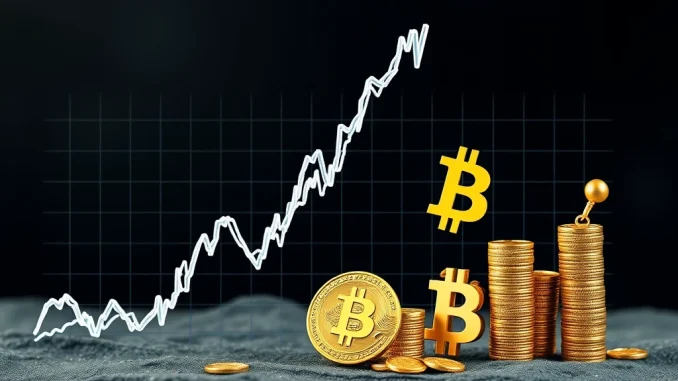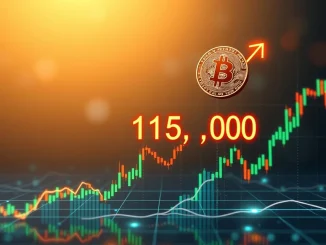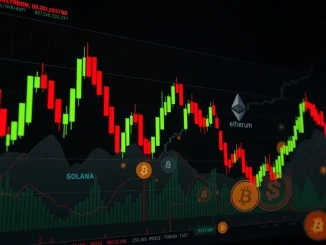
The financial world is buzzing after a significant move by global credit rating agency Moody’s. They’ve downgraded the U.S.’s credit rating, a decision that has put a spotlight on alternative assets like Bitcoin and gold. For anyone following the cryptocurrency market or looking for ways to preserve wealth in uncertain times, this development is crucial.
Understanding the U.S. Credit Downgrade
Moody’s decision to lower the U.S. credit rating from its top-tier AAA status to AA1 wasn’t made lightly. The agency cited growing concerns over the country’s fiscal health, specifically pointing to its ballooning national debt and the increasing cost of servicing that debt.
Here are the key figures that underline Moody’s concerns:
- National Debt: The U.S. national debt has climbed to a staggering $36.2 trillion.
- Fiscal Deficit: The country is currently running a significant fiscal deficit of $1.05 trillion.
- Interest Costs: With the 10-year Treasury yield around 4.48%, the interest burden on the debt is now considerably higher compared to other developed nations.
This downgrade places the U.S. in a different category, sharing its AA1 rating with countries like Austria and Finland, as noted by experts.
Why This Downgrade Impacts Safe Haven Assets
When a major economy like the U.S. sees its credit rating fall, it signals potential instability or increased risk. Investors and individuals often look for ways to protect their wealth from economic headwinds, currency devaluation, or market volatility. This is where the concept of safe haven assets becomes relevant.
Historically, gold has been the go-to safe haven asset, prized for its intrinsic value and perceived stability during times of crisis. However, in recent years, Bitcoin has also emerged as a potential alternative, often dubbed ‘digital gold’.
Expert Perspective from Kitco News
Michelle Makori, editor-in-chief at Kitco News, a prominent voice in the precious metals market, quickly weighed in on the implications of the U.S. credit downgrade. She highlighted the shift in the U.S.’s financial standing relative to peer nations.
Makori’s key takeaway for investors is direct: “Hard assets don’t lie. Watch gold and Bitcoin.” Her statement underscores the view that tangible or digitally scarce assets, unlike government-issued currencies or debt, hold their value independently of a single nation’s financial health.
Bitcoin and Gold: The Case for Hard Assets
Both Bitcoin and gold offer characteristics that appeal to those seeking safe havens:
- Scarcity: Gold is physically limited, and Bitcoin has a capped supply of 21 million coins. This scarcity contrasts with the potentially unlimited printing of fiat currency or accumulation of national debt.
- Decentralization/Independence: Gold exists outside any single government’s control. Bitcoin operates on a decentralized network, independent of central banks or national policies.
- Store of Value: Proponents argue that their limited supply and independence make them effective stores of value, particularly when confidence in traditional financial systems or currencies wanes due to factors like rising national debt.
While gold has a centuries-old track record, Bitcoin’s performance as a safe haven is still being tested over time. However, its behavior during certain periods of economic uncertainty suggests it is increasingly being considered in this role by investors.
Actionable Insight: What to Watch
The U.S. credit downgrade is a reminder of the economic pressures facing major economies. As suggested by experts, keeping an eye on the performance of both gold and Bitcoin in the wake of such events can provide insight into market sentiment regarding traditional financial stability versus alternative assets.
Whether you are an investor, a crypto enthusiast, or simply concerned about the global economy, understanding the potential implications of credit downgrades on assets like Bitcoin and gold is essential for navigating today’s financial landscape.
Conclusion
Moody’s downgrade of the U.S. credit rating is a significant event, driven by concerns over national debt and rising interest costs. This move has amplified the discussion around safe haven assets. As Kitco News points out, the focus is now sharper on hard assets like Bitcoin and gold. While they serve different purposes and appeal to different investor types, both are seen by many as potential hedges against the kind of economic uncertainty highlighted by this U.S. credit downgrade. Monitoring their performance will be key in the coming months as the market reacts to shifting global economic realities.



